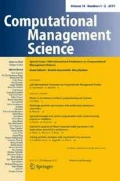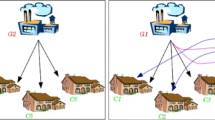Abstract
This paper investigates the costs of monitoring of a distributed multi-agent economic activity in the presence of constraints on the agents’ joint outputs. If the regulator monitors agents individually she calculates each agent’s optimal contribution to the constrains by solving a constrained welfare-maximisation problem. This will maximise welfare but may be expensive because monitoring cost rises with the number of agents. Alternatively, the regulator could monitor agents collectively, using a detector, or detectors, to observe if each constraint is jointly satisfied. This will ease implementation cost, but lower welfare. We define the welfare difference between each regime of monitoring for a fairly inclusive electricity generation model and formulate some predictions. The behaviour of two generators in a coupled-constrained, three-node case study reproduces these predictions. We find that the welfare loss from collective monitoring can be small if the constraints are tight. We also learn that, under either regime, the imposition of transmission and environmental restrictions may benefit the less efficient generator and shift surplus share towards the emitters, decreasing consumer surplus.






Similar content being viewed by others
Notes
This paper builds on Contreras et al. (2007).
In particular, Downward (2010) has found that when the carbon tax increases generation costs, it also reduces prices, eliminates congestion and increases consumers’ welfare, but total emissions increase. This paradox is due to a combination of strategic producers and the single transmission constraint. It happens that, in their example, the Nash-Cournot equilibrium with carbon charges subject to strategic bids and the sole transmission constraint provides better societal welfare.
In this class of models, the power flows comply with the Kirchhoff’s first law that, originally, deals with currents and not MW. However, for the linearised DC models like ours, we can use the Kirchhoff’s law to infer about the power flows under two basic assumptions: small voltage angle differences and negligible line resistance. This is what we assume about the transmission network in this paper; see Purchala et al. (2005) for details.
To represent the topology of the network it is necessary to select one node as the reference node. This is called the slack node or swing node (see Expósito et al. 2008 for details). Here, the slack node is slack node is node (or bus) number 3.
Note that, throughout this paper, we use the notation \(|\mathbf {P}_{i \rightarrow j}|\) to denote a vector with each element being the absolute value of the corresponding element of \(\mathbf {P}_{i \rightarrow j}\). It is not intended to represent the norm of a vector.
Reference Chu et al. (1977) refers to the integrated Gaussian puff model, for which the use of the superposition principle is justified.
Some authors e.g., Harker (1991), Pang and Fukushima (2005), call this equilibrium generalised Nash (GNE). Some of them (e.g., Facchinei et al. 2009, 2007; Facchinei and Kanzow 2007; Fukushima 2011; Harker 1991; von Heusinger and Kanzow 2009 or Pang and Fukushima 2005) further distinguish between coupled and shared constraints; however, this distinction is frequently blurred. In our paper, some might call constraints (10) and (12) shared, but for most of this paper we will follow Rosen (1965) and use the term “coupled”. For a rather general introduction to this game solution concept we refer the reader to Boucekkine et al. (2010).
If they were active, formula (18) would have more terms responsible for the other constraints.
The above derivatives arise from differentiation of \( T_{\ell }(\lambda , \mathbf {s})\), see (16).
In this paper, the choice of the responsibility weights \(\mathbf{r}\) is \([1,\,\,1]\).
The exact data on monitors are commercially sensitive.
All solutions are results obtained from NIRA, a Matlab based software suite of routines, designed to compute equilibria in infinite games, see Krawczyk and Townsend (2014a, b), first applied in Krawczyk and Uryasev (2000) and Contreras et al. (2004); also, consult Berridge and Krawczyk (1997) and Krawczyk and Zuccollo (2007). Briefly, NIRA uses a relaxation algorithm to min-maximise the Nikaido-Isoda function. Other methods suitable for quasi-variational inequality problems, as our problem can be qualified (see Pang and Fukushima 2005), may also be used. While each method will perform satisfactorily in this linear-quadratic case (see Mathiesen 2007), the methods based on the use of the Nikaido-Isoda function enjoy an attractive economic interpretation as maximisation of the Nikaido-Isoda function means maximisation of the payoffs’ improvements, see e.g., Krawczyk (2007). However, perhaps more importantly, they are more general, being suitable for nonsmooth games, see von Heusinger and Kanzow (2009).
References
Berridge S, Krawczyk JB (1997) Relaxation algorithms in finding Nash equilibria. Economic Working Papers Archive, http://econwpa.wustl.edu/eprints/comp/papers/9707/9707002.abs
Boucekkine R, Krawczyk JB, Vallée T (2010) Towards an understanding of tradeoffs between regional wealth, tightness of a common environmental constraint and the sharing rules. J Econ Dyn Control 34(9):1813–1835
Chu KC, Jamshidi M, Levitan R (1977) An approach to on-line power dispatch with ambient air pollution constraints. IEEE Trans Autom Control 22(3):385–396
Contreras J, Klusch M, Krawczyk JB (2004) Numerical solutions to Nash-Cournot equilibria in coupled constraint electricity markets. IEEE Trans Power Syst 19(1):195–206
Contreras J, Krawczyk JB, Zuccollo J, García J (2013) Competition of thermal electricity generators with coupled transmission and emission constraints. J Energy Eng 139(4):239–252. doi:10.1061/(ASCE)EY.1943-7897.0000113
Contreras J, Krawczyk JB, Zuccollo J (2007) Electricity market games with constraints on transmission capacity and emissions. In: 30th Conference of the International Association for Energy Economics, Wellington, New Zealand, http://hdl.handle.net/10063/521
Contreras J, Krawczyk JB, Zuccollo J (2008) The invisible polluter: Can regulators save consumer surplus? In: 13th International Symposium of the International Society of Dynamic Games, Wrocław, Poland, pp 1–32, http://hdl.handle.net/10063/528
Downward A (2010) Carbon charges in electricity markets with strategic behavior and transmission. Energy J 31(4). http://econpapers.repec.org/RePEc:aen:journl:2010v31-04-a07
Drouet L, Haurie A, Moresino F, Vial JP, Vielle M, Viguier L (2008) An oracle based method to compute a coupled equilibrium in a model of international climate policy. Comput Manage Sci 5:119–140
Expósito AG, Conejo AJ, Cañizares C (2008) Electric energy systems: Analysis and operation. CRC
Facchinei F, Fischer A, Piccialli V (2007) On generalized Nash games and variational inequalities. Oper Res Lett 35:159–164
Facchinei F, Fischer A, Piccialli V (2009) Generalized Nash equilibrium problems and newton methods. Math Program Ser B 117:163–194
Facchinei F, Kanzow C (2007) Generalized Nash equilibrium problems. Q J Oper Res 5(3):173–210
Fukushima M (2011) Restricted generalized Nash equilibria and controlled penalty algorithm. Comput Manage Sci 8(3):201–218
Harker PT (1991) Generalized Nash games and quasivariational inequalities. Eur J Oper Res 4:81–94
Haurie A, Krawczyk JB (1997) Optimal charges on river effluent from lumped and distributed sources. Environ Model Assess 2:177–189
Hobbs BE (2001) Linear complementarity models of Nash-Cournot competition in bilateral and POOLCO power markets. IEEE Trans Power Syst 16(2):194–202
Holmstrom B (1982) Moral hazard in teams. Bell J Econ 13(2):324–340
Karp L (2005) Nonpoint source pollution taxes and excessive tax burden. Environ Resour Econ 31(2):229–251
Krawczyk JB, Contreras J, Zuccollo J (2008) Thermal electricity generators’ competition with coupled constraints. In: Conference Abstracts of the International Conference on Modeling, Computation and Optimization, Indian Statistical Institute, Delhi Centre
Krawczyk JB, Tidball M (2009) How to use Rosen’s normalised equilibrium to enforce a socially desirable Pareto efficient solution. Working Papers 09-20, LAMETA, Universtiy of Montpellier, http://ideas.repec.org/p/lam/wpaper/09-20.html
Krawczyk JB, Townsend W (2014a) A MATLAB application which solves for couple-constraint Nash equilbria–NIRA-GUI Code. https://code.google.com/p/nira-gui/
Krawczyk JB, Townsend W (2014b) NIRA-GUI: a Matlab application which solves for coupled-constraint Nash equilibria from a symbolic specification–NIRA Manual. SEF Working Paper 07/2014, Victoria University of Wellington, http://docs.google.com/file/d/0B39JLTTdR-V8cVVVT0M5QVU4Z0k/edit
Krawczyk JB, Zuccollo J (2007) NIRA-3: an improved MATLAB package for finding Nash equilibria in infinite games. Munich Personal RePEc Archive, http://mpra.ub.uni-muenchen.de/1119/
Krawczyk JB (2005) Coupled constraint Nash equilibria in environmental games. Resour Energy Econ 27:157–181
Krawczyk JB (2007) Numerical solutions to coupled-constraint (or generalised) Nash equilibrium problems. Comput Manage Sci 4:183–204. doi:10.1007/s10287-006-0033-9
Krawczyk JB, Uryasev S (2000) Relaxation algorithms to find Nash equilibria with economic applications. Environ Model Assess 5:63–73
Maiorano A, Song Y, Trovato M (2000) Dynamics of noncollusive oligopolistic electricity markets. In: Proceedings of IEEE Power Eng. Soc. Winter Meeting, IEEE PES, Singapore, pp 838–844
Mathiesen L (July 2007) A Cournot model with coupled constraints. The Norwegian School of Economics and Business Administration, Bergen, Working Paper
Muslu M (2004) Economic dispatch with environmental considerations: treadeoff curves and emission reduction rates. Electr Power Syst Res 71:153–158
Pang JS, Fukushima M (2005) Quasi-variational inequalities, generalized Nash equilibria and multi-leader-follower games. Comput Manage Sci 1:21–56
Papavasiliou A, Chen Y, Oren SS (2009) Environmental regulation in transmission-constrained electricity markets. Power and Energy Society General Meeting. IEEE, Calgary, pp 1–8
Purchala K, Meeus L, van Dommelen D, Belmans R (2005) Usefulness of dc power flow for active power flow analysis. Power and Energy Society General Meeting. IEEE, San Francisco, pp 454–459
Ramanathan R (1994) Emission constrained economic dispatch. IEEE Trans Power Syst 9(4):1994–2000
Rosen JB (1965) Existence and uniqueness of equilibrium points for concave n-person games. Econometrica 33(3):520–534
Sánchez-Marín P, Ramos A, Alonso J (2005) Probabilistic midterm transmission planning in a liberalized market. IEEE Trans Power Syst 20(4):2135–2142
Segerson K (1988) Uncertainty and incentives for nonpoint pollution control. J Environ Econ Manage 15(1):87–98
Segerson K, Wu J (2006) Nonpoint pollution control: Inducing first-best outcomes through the use of threats. J Environ Econ Manage 51(2):165–184
von Heusinger A, Kanzow C (2009) Optimization reformulations of the generalized Nash equilibrium problem using Nikaido-Isoda-type functions. Comput Optim Appl 43(3):353–377
Wood AJ, Wollenberg BF (1984) Power generation. Operation and control. John Wiley & Sons Inc, New York
Xepapadeas AP (1991) Environmental policy under imperfect information: incentives and moral hazard. J Environ Econ Manage 20(2):113–126
Acknowledgments
Helpful comments and clarification questions by audience of the 2012 Workshop on Complementarity And Its Extensions organised by the Institute for Mathematical Sciences (National University of Singapore) in December 2012 are gratefully acknowledged. We are also very thankful to M. Fukushima, J.-S. Pang, P. Calcott and V. Petkov for their remarks on GNE, the Rosen weights’ importance and relaxation algorithms. Multiple and valuable contributions by Amanda Campbell and Wilbur Townsend supported by VUW Grant URG 1620 3230 200757 are whole-heartedly acknowledged. We also acknowledge support for the first author by the Spanish Ministry of Science and Technology through CICYT Grant ENE2009-09541 and Kyoto University Institute of Economic Research (KIER) for hosting the second author in 2009, during the early stages of this paper. All remaining errors are ours.
Author information
Authors and Affiliations
Corresponding author
Rights and permissions
About this article
Cite this article
Contreras, J., Krawczyk, J.B. & Zuccollo, J. Economics of collective monitoring: a study of environmentally constrained electricity generators. Comput Manag Sci 13, 349–369 (2016). https://doi.org/10.1007/s10287-015-0247-9
Received:
Accepted:
Published:
Issue Date:
DOI: https://doi.org/10.1007/s10287-015-0247-9
Keywords
- Coupled-constraints games
- Generalised Nash equilibrium
- Deregulated electric industry
- Pollution constraints
- Policy analysis




